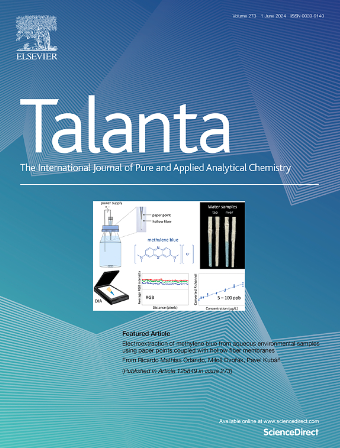基于分子印迹聚合物的毛细管电泳富集与分离
IF 5.6
1区 化学
Q1 CHEMISTRY, ANALYTICAL
引用次数: 0
摘要
毛细管电泳(CE)以其高分辨率、快速、低样品和试剂消耗以及能够简单地改变分离模式而闻名,已广泛用于许多领域重要的各种分析物的分离和检测。一个主要的限制是检测的浓度限制,在具有显著基质成分的复杂样品中可能会进一步恶化。基于分子印迹聚合物(MIPs)的固相萃取(SPE)和固定相(SPs)因其识别特异性、物理鲁棒性、热稳定性以及制备成本低等优点,在CE领域受到广泛应用。因此,本文对近年来MIPs-SPE和MIPs-SPs富集分离技术在CE痕量分析中的研究进展进行了综述。据我们所知,这项工作是第一篇围绕mip如何提高CE性能这一主题的综述,并提供了比现有综述有意义的进步。讨论了三种提高CE性能的方法,包括不同的CE模式,在线/离线分子印迹SPE (MISPE)与CE耦合,以及在毛细管中用作SPs的MIPs。随后,总结了MISPE和MIPs-SPs在食品安全、生物医学和环境监测等领域各种分析物CE测定中的典型应用。最后,提出了精细制备mip、合理选择CE模式、迫切开发便携式CE设备等可能面临的挑战和前景,以提高CE的检测能力和扩大其实际应用。本文章由计算机程序翻译,如有差异,请以英文原文为准。

Molecularly imprinted polymers based enrichment and separation for trace analysis in capillary electrophoresis
Capillary electrophoresis (CE) is well known for its high resolution, rapidity, low sample and reagent consumption, and ability to simply change separation modes, and has been widely used for separation and detection of various analytes important for many fields. One major limitation is the concentration limits of detection, which can be further worsened in complex samples with a significant matrix component. Molecularly imprinted polymers (MIPs) based solid-phase extraction (SPE) and stationary phases (SPs) enjoy great popularity in CE, owing to the recognition specificity, physical robustness, thermal stability, as well as low cost and easy preparation of MIPs. Therefore, herein, recent advances in MIPs-SPE and MIPs-SPs based enrichment and separation for trace analysis in CE are comprehensively reviewed. To the best of our knowledge, this work is the first review covering this topic centered on how MIPs improve CE performance, and provides meaningful advancement over the existing reviews. Three types of approaches to improving CE performance are discussed, including different CE modes, on/off-line molecularly imprinted SPE (MISPE) coupled with CE, and MIPs used as SPs in capillary. Subsequently, typical applications of MISPE and MIPs-SPs for CE determination of a variety of analytes in the fields of food safety, biological medicine and environmental monitoring are summarized. Finally, the possible challenges and perspectives, such as elaborate preparation of MIPs, rational selection of CE modes, pressing development of portable CE devices, are proposed, for promoting CE's detection capability and expanding its real-world applications.
求助全文
通过发布文献求助,成功后即可免费获取论文全文。
去求助
来源期刊

Talanta
化学-分析化学
CiteScore
12.30
自引率
4.90%
发文量
861
审稿时长
29 days
期刊介绍:
Talanta provides a forum for the publication of original research papers, short communications, and critical reviews in all branches of pure and applied analytical chemistry. Papers are evaluated based on established guidelines, including the fundamental nature of the study, scientific novelty, substantial improvement or advantage over existing technology or methods, and demonstrated analytical applicability. Original research papers on fundamental studies, and on novel sensor and instrumentation developments, are encouraged. Novel or improved applications in areas such as clinical and biological chemistry, environmental analysis, geochemistry, materials science and engineering, and analytical platforms for omics development are welcome.
Analytical performance of methods should be determined, including interference and matrix effects, and methods should be validated by comparison with a standard method, or analysis of a certified reference material. Simple spiking recoveries may not be sufficient. The developed method should especially comprise information on selectivity, sensitivity, detection limits, accuracy, and reliability. However, applying official validation or robustness studies to a routine method or technique does not necessarily constitute novelty. Proper statistical treatment of the data should be provided. Relevant literature should be cited, including related publications by the authors, and authors should discuss how their proposed methodology compares with previously reported methods.
 求助内容:
求助内容: 应助结果提醒方式:
应助结果提醒方式:


